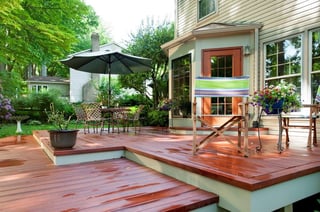
People are always asking us how they protect their decks during the cold and blustery winter months so there’s no damage or excessive wear-and-tear when the spring comes. As long as your deck was properly installed and maintained, you don’t really need to worry because they are designed to withstand the snow and ice that come with winter storms.
However, this doesn’t mean there aren’t things you should do to get your deck ready for the winter. Just like you winterize your car, you should winterize your deck to minimize the effects the elements will have on it. But what should you do exactly? And when?
How to properly winterize your wood or synthetic deck
Q: When to winterize your deck? A: Start the deck winterization process right after Thanksgiving at the latest.
Depending on where you live, you may have already faced intense winter storms that brought snow and ice, so the beginning of November – or even earlier – is a great time to get your deck ready for the season.
But, particularly in the Virginia and Maryland area, there are often warmer days that still pop up on the calendar, so you may want to use your deck as an entertainment space for the Thanksgiving holiday if the weather allows it. So make it part of your routine to prep your woed or synthetic deck during turkey day weekend.
1. Clear it off.
Whether you just like sitting out on your deck all by your lonesome or you’re the type to invite friends over for barbecues and cocktails, chances are probably good that you have items out on the deck that aren’t meant for sleet and snow, such as planters and seat cushions, just to name a few.
Anything that you’re worried about leaving out for the winter should be brought inside and stored to keep it safe. This is good both for those items and the deck, because when wet, moldy cushions and decaying plants just sit on your deck for months, it can lead to problems. Speaking of which…
2. Get rid of all those leaves.
If you leave fallen leaves on your deck and it snows, they’ll be smashed into the deck and bleed into it over time. You have to sweep them all off so the deck is completely clear if you want to be safe. This is a bigger issue for wood decks than synthetic decks, since the stains will be superficial and easier to clean off quality synthetic materials.
Also, if your deck attaches to your house, make sure to clean out the gutters and nearby windows so debris doesn’t fall from there and cause issues.
3. Buy the right grill cover.
Did you know that grill covers that contain some rubber compounds or are made of vinyl can cause your PVC decking to become discolored? It’s called Antioxidant Staining or Plasticizer Migration, and it happens both when water drips off of these products and when it gets trapped under them. You should be able to tell if your grill cover might have this issue by reading through the warranty information.
A way around it? Just store your grill in the garage for the season instead. It will provide better protection for your deck and grill anyway.

4. Fix any issues related to wear-and-tear.
Before the snow really starts falling, you want to give it a good once-over for any potential issues. If you notice damage or other issues, deal with it ahead of the coldest months of the year. This might mean replacing cracked or rotting planks, resealing, or even dealing with mold or mildew. Different products are recommended depending on your issue and the material your deck is made from.
5. Work with a professional.
If you’re not completely sure what you should do to get your deck ready for the winter, or how to repair any issues you notice before or during the season, the best course of action is to give a professional a call. A contractor who installs decks for a living will be able to provide you with a plan of action, so your deck survives the winter months intact and looks good as new when you’re ready to use it again in the spring and summer.


